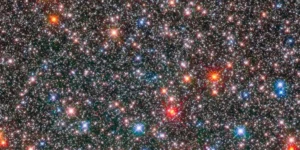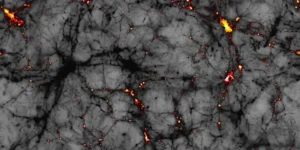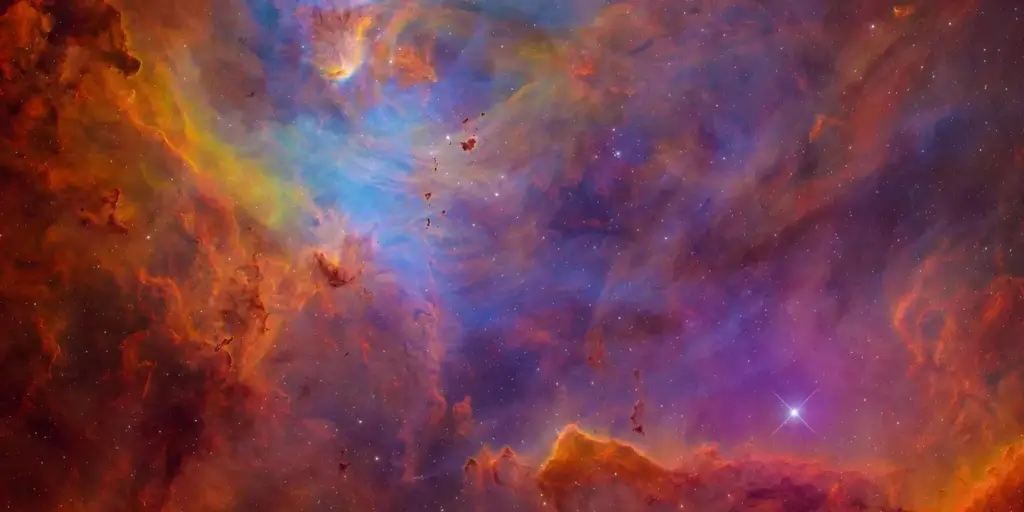Recently updated on June 23rd, 2025 at 09:36 am
Astronomy is the scientific study of celestial objects, space, and the universe in general. It entails seeing and comprehending different phenomena, including stars, planets, galaxies, and cosmic events. Astronomers collect data using telescopes and other instruments to learn more about these objects’ features, behaviour, and origins. The area includes several sub-disciplines, such as astrophysics, planetary science, and cosmology, which investigate anything from star life cycles to the universe’s large-scale structure.
1. What are the main types of celestial objects studied in astronomy?

The primary categories of celestial objects investigated in astronomy are as follows:
Stars: Stars are large, bright objects made mostly of helium and hydrogen that are undergoing nuclear fusion. The Sun, red giants, and supernova remnants are a few examples.
Planets: Planets are big celestial objects that revolve around stars. They are separated into:
- Terrestrial Planets: Rocky planets like Earth, Mars, Venus, and Mercury are known as terrestrial planets.
- Gas Giants: Gas giants are larger planets, like Jupiter and Saturn, primarily made of gases.
- Ice Giants: Ice giants, such as Uranus and Neptune, are planets with substantial ice compositions.
Moons: Moons are planets’ natural satellites in orbit. Like Jupiter’s and Earth’s moons, they differ in size and makeup.
Asteroids: Small, stony objects in the asteroid belt between Mars and Jupiter that circle the Sun. Their shapes and sizes differ.
Comets: Comets are icy bodies that, when they get closer to the Sun, generate a luminous coma and tail. They are made of rock, dust, and ice.
Dwarf Planets: Dwarf planets are celestial bodies that resemble planets but are too small to pass through their orbits. Haumea, Eris, and Pluto are a few examples.
Galaxies: Galaxies are enormous systems held together by gravity that are made up of billions of stars, gas, dust, and dark matter. Our galaxy is the Milky Way.
Nebulae: Nebulae are space-based gas and dust clouds. These could be areas of star formation, stellar nurseries—where new stars are formed—or the remains of dead stars.
Black Holes: Spacetime regions known as “black holes” have gravitational fields so powerful that nothing can escape from them. After supernovae, they are created from the remains of huge stars.
Neutron Stars: Neutron stars are extremely intense supernova explosion leftovers made mostly of neutrons.
Quasars: Exceptionally bright, far-off objects driven by supermassive black holes at galaxies’ centres. They are among the universe’s most brilliant objects and release enormous amounts of energy.
Pulsars: Pulsars are rotating neutron stars that whirl about Earth and release radiation beams that are detectable as pulses.
2. What is in astronomy?

The scientific study of celestial objects, phenomena, and the universe at large is known as astronomy. It covers many different subjects, such as:
Celestial Bodies: The study of stars, planets, moons, comets, asteroids, and galaxies is known as celestial bodies.
Cosmology: Studying the Big Bang and cosmic inflation, as well as the universe’s formation, evolution, and structure.
Astrophysics: Astrophysics is the use of physics to comprehend the behaviour of celestial entities, including their interactions, composition, and energy production.
Stellar Evolution: Stellar evolution is the study of stars, including black holes, neutron stars, and supernovae, and how they arise, change, and end their lives.
Planetary Science: Planetary science is the study of planets, including exoplanets, and their surfaces, atmospheres, and capacity to support life.
Galactic Astronomy: Studying the dynamics and structure of galaxies, such as our own Milky Way, as well as their genesis and development, is known as galactic astronomy.
Extragalactic Astronomy: The study of things outside of our galaxy, such as other galaxies, galaxy clusters, and the universe’s large-scale structure, is known as extragalactic astronomy.
Astrobiology: The study of life beyond Earth, including the conditions required for life and the hunt for life elsewhere in the universe.
Observational Techniques: Radio, optical, and infrared observations of astronomical objects are made using telescopes and other devices.
Theoretical Astronomy: The creation of models and simulations to explain astronomical phenomena and forecast future occurrences is known as theoretical astronomy.
Astrometry: the measurement of celestial objects’ locations and motions, which is essential to comprehending their orbits and distances.
Gravitational Waves: Studying the rippling effects of massively accelerated entities in spacetime, gravitational waves shed light on phenomena such as black hole mergers.
3. How do astronomers determine the age of stars?

Astronomers use a few primary techniques to estimate the age of stars:
Stellar Evolution Models: Based on a star’s location on the Hertzsprung-Russell diagram, astronomers can estimate its age by comparing its brightness and temperature to theoretical models.
Isochrones: Astronomers employ isochrones, or groups of stars with the same age but differing masses, to symbolise star clusters. They can calculate age by charting the positions of the stars in a cluster and comparing them to these lines.
Primary Order Turn-off: As more massive stars grow more quickly, the point in star clusters where stars begin to leave the main sequence (the main sequence turn-off) determines the age of the cluster.
Asteroseismology: This method examines a star’s oscillations to determine its age and interior composition. Details about evolution can be revealed by the oscillation frequencies.
White Dwarf Cooling: White dwarf cooling rates can be used by astronomers to determine the age of globular clusters, which are composed primarily of older stars.
Chemical Composition: Because some elements are impacted by the star’s evolutionary processes, the abundance of particular elements, such as lithium and beryllium, can reveal a star’s age.
Magnetic Activity: The magnetic activity of younger stars is higher. Astronomers can determine a star’s age by measuring its activity since older stars often have less.
Spectroscopy: By examining a star’s spectrum, one can determine its age by learning more about its surface temperature and chemical composition.
4. What is dark matter, and why is it important for our understanding of the universe?

Dark matter is a type of matter that cannot be found by conventional astronomical investigations because it is invisible and does not emit, absorb, or reflect light. A closer examination of dark matter’s definition and importance is given below:
What is meant by Dark Matter?
- Invisible Matter: Dark matter is invisible to telescopes because it does not interact with electromagnetic forces. Rather, it is identified through its gravitational pull on observable matter.
- Composition: Though its precise makeup is yet unclear, exotic particles like axions and weakly interacting massive particles (WIMPs) are thought to make up dark matter.
- Amount: Ordinary matter (such as stars, planets, and gas) makes up approximately 5% of the universe’s total mass-energy content, but dark matter makes up roughly 27%.
The Significance of Dark Matter:
- Galactic Formation and Structure: Ultimately, the formation and stability of galaxies are largely explained by dark matter. Specifically, its gravitational pull contributes to the structure of galaxy clusters and individual galaxies.
- Cosmic Stability: Furthermore, the rotation curves of galaxies are explained by the presence of dark matter. The notion that outer stars would fly away stems from the fact that galaxies would not have enough mass to keep their stars in orbit without dark matter.
- Large-Scale Structure: Moreover, the universe’s large-scale structure is significantly influenced by dark matter. Consequently, it serves as a framework for the clustering of galaxies, which affects the distribution of observable matter.
- Cosmological Models: In addition, one of the mainstays of the contemporary cosmological models that explain the evolution of the universe is dark matter. As a result, it aids in the explanation of phenomena like the universe’s expansion rate and cosmic microwave background radiation.
- Possible New Physics: Therefore, researching dark matter could reveal things about the nature of the cosmos and fundamental forces that go beyond the scope of particle physics’s Standard Model.
Conclusion
In summary, the study of astronomy is, indeed, a broad and dynamic discipline that aims to solve all of the universe’s secrets, from the smallest celestial bodies to the biggest cosmic structures. Furthermore, to gain a deeper understanding of the underlying principles of nature and the universe’s evolution, it includes the study of stars, planets, galaxies, and phenomena like dark matter and dark energy.
Consequently, astronomers constantly deepen our understanding of the universe’s origins, composition, and destiny by using cutting-edge observational techniques and theoretical models.







5757winbet
October 16, 2024Recently tried 5757winbet and I’ve been having a great time!. I would definitely recommend that you give em a look and check em out at 5757winbet.
slot365
October 16, 2024Bạn có bao giờ thắc mắc về khả năng ứng dụng công nghệ blockchain để tăng cường tính minh bạch cho các thuật toán RNG? Đây chính là hướng phát triển trang chủ 66b đang nghiên cứu để nâng cao trải nghiệm người dùng trong tương lai.
66b club
October 16, 2024Chỉ trong 5 năm ngắn ngủi, xn88 game đã ghi nhận hơn 5,2 triệu người dùng đăng ký trên toàn hệ thống, với mức tăng trưởng trung bình 48% mỗi quý – một con số ấn tượng mà không phải tân binh nào cũng làm được.
188v vom
October 16, 2024tải 888slot đã xây dựng được niềm tin lớn từ cộng đồng nhờ chú trọng vào yếu tố an toàn và minh bạch trong mọi khâu vận hành. Với quy trình kiểm soát nghiêm ngặt và công nghệ hiện đại, trải nghiệm của người chơi luôn được bảo vệ tối đa ở mọi khía cạnh.
xn88 link
October 16, 202466b Chúng tôi mang đến cho bạn trải nghiệm live casino chân thực ngay trên ứng dụng di động. Bạn có thể tham gia các trò chơi casino phổ biến như Baccarat, Blackjack, Roulette và Sicbo với những dealer xinh đẹp và chuyên nghiệp.
bet191livelogin
October 16, 2024Yo Bet191livelogin, man I gotta say, the live action here is top-notch! Been having a solid time with their platform. Definitely worth checking out! Get in on the fun at bet191livelogin.
HenyEmema
October 16, 2024Мы делаем интернетсайты, которые привлекают клиентов и увеличивают продажи.
Почему нужно выбрать нас?
Качественный дизайн, который удерживает взгляд
Адаптация под все устройства (ПК, смартфоны, планшеты)
SEO-оптимизация для роста в Google
Скорость загрузки — никаких медленных страниц
Специальное предложение:
Первым 4 клиентам — дисконт 9% на разработку сайта!
Готовы обсудить проект?
Позвоните нам!
[url=https://startoviidei.xyz/]Студия startoviidei.xyz[/url]